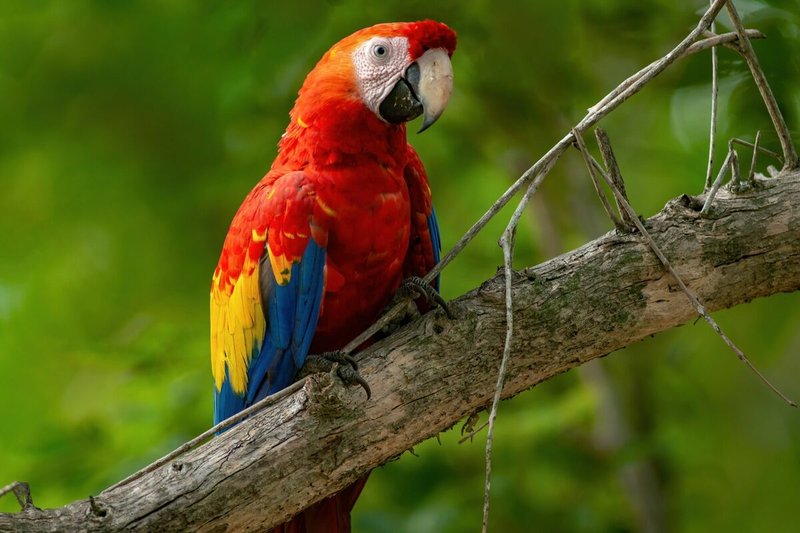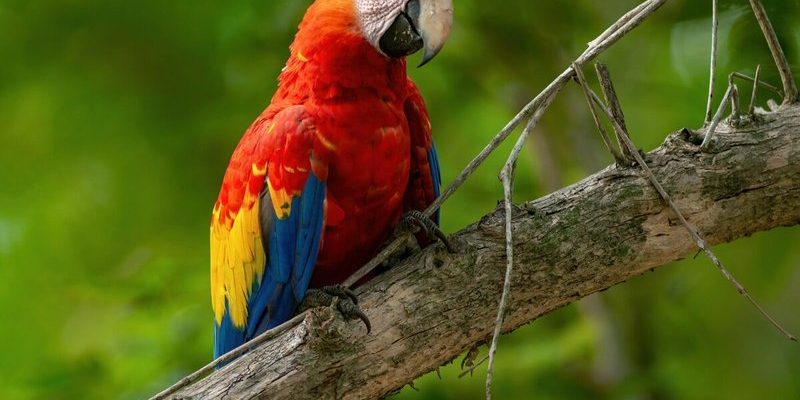
But their role goes far beyond just being eye candy for birdwatchers or tourists. In many native cultures, macaws are woven into myths, legends, and everyday life. They often represent something much deeper—a connection between the heavens and the earth, the wild and the civilized. Let’s dive into how these magnificent birds are viewed in different cultures, exploring their significance and the stories that swirl around them.
Macaws in Indigenous Cultures
In many indigenous cultures of South America, macaws aren’t just another part of the scenery; they are viewed as sacred beings. Take the Amazon Basin, for instance. Here, macaws like the scarlet macaw are believed to embody the spirits of the forest. They are often seen as messengers between the human world and the spirit world, capable of bringing important messages from ancestors.
These birds are sometimes featured in ceremonies and rituals, symbolizing strength, courage, and beauty. The vibrant colors of their feathers are not just for show; they represent the diversity of life in the jungle. During specific festivals, feathers are used in ceremonial garb, signifying respect and reverence for these magnificent creatures. So, next time you see a macaw, remember that it might be more than just a bird—it’s a vital part of a cultural tapestry.
Folktales and Legends
Macaws often play starring roles in local folktales and myths, helping to shape the identities of various communities. In one popular tale among the Guarani people, a beautiful macaw saves a village by alerting them to danger from a predator. The bird’s keen eyesight and ability to fly high make it a symbol of vigilance and bravery. This story is just one of many, illustrating how macaws are often seen as guardians and protectors.
In other legends, the macaw is associated with creation myths. Some stories depict them as creatures that brought light to the world or as symbols of fertility, representing how life springs forth from the vibrancy of nature. When you listen to these tales, you can almost feel the connection the local cultures have with the land and the animals that inhabit it.
Macaws as Cultural Symbols
Beyond their roles in stories, macaws are also powerful cultural symbols. Their striking appearances and loud calls make them easy to identify, making them natural icons for various communities. For instance, the blue-and-yellow macaw is often seen as a symbol of national pride in some countries, reflecting the rich biodiversity of the region.
In traditional art and crafts, you might find macaws depicted in pottery, textiles, or carvings. These representations not only showcase the beauty of the birds but also serve to remind people of their importance in local lore and daily life. By incorporating macaws into their art, communities convey their respect and admiration for these stunning creatures.
Relationships with the Environment
Here’s the thing: the relationship between macaws and the environment is as intricate as the patterns on their feathers. For many local cultures, macaws represent the health of the ecosystem. Their presence indicates a balanced environment, and their disappearance can signal the need for ecological intervention. This understanding fosters a deep respect for nature.
Many indigenous tribes believe that caring for macaws is akin to caring for the forest itself. They practice sustainable hunting and promote conservation efforts, recognizing that these birds are integral to the ecosystem. By protecting macaws, communities take a stand against deforestation and habitat loss, ensuring that future generations can continue to coexist with these vibrant beings.
Macaws in Modern Culture
While macaws have deep historical roots, they haven’t faded from modern culture. Instead, they’ve become symbols of conservation and awareness. Many organizations and activists focus on protecting these birds, leveraging their beauty to draw attention to broader environmental issues.
For instance, movies and documentaries featuring macaws have raised awareness about the threats they face, like habitat destruction and the illegal pet trade. These films often highlight the importance of preserving their natural habitats, illustrating how macaws can inspire change on a global scale. By showcasing their colorful personalities, filmmakers remind us of the urgent need for conservation efforts around the world.
Macaws and Ecotourism
Ecotourism is another modern way macaws play a role in local cultures. By attracting tourists, communities can benefit economically while promoting conservation. Many places offer guided tours where visitors can see macaws in their natural habitats, helping to fund local projects aimed at preserving these birds and their environments.
This relationship can be mutually beneficial. Tourists get to experience the breathtaking beauty of macaws up close, while local communities gain the resources they need to continue protecting their natural heritage. It’s a win-win situation that highlights how economic opportunity and environmental awareness can go hand in hand.
Challenges Facing Macaws Today
Unfortunately, macaws face a range of challenges that threaten their survival. Habitat loss is one of the biggest issues, as deforestation continues to wipe out the lush forests they call home. Urban expansion and agriculture also contribute to this loss, fragmenting their habitats and making it harder for them to find food and mates.
Additionally, the illegal pet trade poses a significant threat. Many people are drawn to these gorgeous birds as pets, leading to overhunting and capturing from the wild. When macaws are taken from their natural environments, it not only endangers their populations but also disrupts the delicate balance of the ecosystems they inhabit.
Now more than ever, it’s crucial to support conservation initiatives focused on protecting these birds and their habitats. Whether through donations or simply spreading awareness, everyone can play a part in ensuring that macaws continue to thrive for generations to come.
Exploring the role of the macaw in local cultures and folklore reveals so much about our connection to nature. These spirited birds are more than just fleeting glimpses of color in the forest; they carry with them deep meanings and stories that resonate across generations. From indigenous rituals to modern conservation efforts, macaws symbolize beauty, strength, and the intricate bond between humans and the environment.
As we look toward the future, it’s essential to recognize and celebrate the cultural significance of macaws. By valuing their role in local traditions and investing in their protection, we can ensure that these splendid creatures continue to delight and inspire people around the world. So, the next time you hear the squawk of a macaw, take a moment to appreciate not just the bird itself, but the rich tapestry of life and lore it represents.

